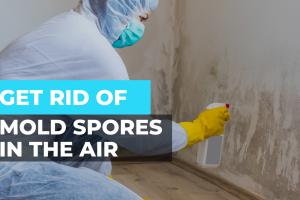Ultimate Guide to Killing Mold Spores in the Air and Preventing Mold Growth

-
Quick Links:
- Introduction
- Understanding Mold and Its Spores
- Health Risks Associated with Mold
- Identifying Mold Spores in Your Home
- How to Kill Mold Spores in the Air
- Techniques to Prevent Mold Growth
- Real-World Case Studies
- Expert Insights on Mold Management
- FAQs
- Conclusion
Introduction
Mold is a common problem that many homeowners face, often without realizing how much it can affect their health and home environment. This guide will provide you with in-depth knowledge on how to effectively kill mold spores in the air and prevent future mold growth. Understanding the nature of mold and its spores, identifying them in your home, and implementing effective strategies will help you maintain a healthier indoor environment.
Understanding Mold and Its Spores
Mold is a type of fungus that thrives in damp and humid environments. It reproduces through tiny spores that can be easily dispersed in the air, leading to potential health risks for residents. There are various types of mold, with some being more dangerous than others. Understanding these differences is crucial for effective management.
Types of Mold
- Aspergillus: Commonly found indoors; can cause respiratory issues.
- Cladosporium: Often found in carpets and fabrics; linked to allergic reactions.
- Stachybotrys (Black Mold): Known for producing mycotoxins; poses serious health risks.
Health Risks Associated with Mold
Exposure to mold can lead to various health problems, especially for individuals with pre-existing conditions. Symptoms may include:
- Respiratory issues
- Allergic reactions
- Skin irritations
- Fatigue and headaches
In severe cases, especially with toxic mold, long-term exposure can lead to more serious health complications.
Identifying Mold Spores in Your Home
Identifying mold spores early can prevent significant health risks and property damage. Look for:
- Visible mold growth on walls, ceilings, or furniture
- Musty odors
- Increased allergic reactions in household members
How to Kill Mold Spores in the Air
Removing mold spores from the air requires a multi-faceted approach. Here are some effective methods:
1. Use Air Purifiers
Investing in a high-quality air purifier with a HEPA filter can significantly reduce mold spores in the air. These filters capture particles as small as 0.3 microns, including mold spores.
2. Increase Ventilation
Improving airflow in your home can help diminish moisture levels, making it less conducive for mold growth. Open windows and doors or use exhaust fans in high-moisture areas like bathrooms and kitchens.
3. Control Humidity Levels
Keeping indoor humidity between 30% and 50% can inhibit mold growth. Consider using dehumidifiers in damp areas.
4. Regular Cleaning
Frequent cleaning, especially of areas prone to moisture, can help eliminate mold spores. Use mold-killing solutions for surfaces prone to mold growth.
5. Natural Remedies
Natural solutions such as vinegar and tea tree oil have antifungal properties that can help kill mold spores in the air.
Techniques to Prevent Mold Growth
Preventing mold growth is as crucial as killing existing mold. Here are effective prevention strategies:
1. Maintain Your Roof and Gutters
Regularly check your roof for leaks and ensure gutters are clear to prevent water damage.
2. Insulate Pipes
Insulating cold water pipes can prevent condensation and moisture buildup.
3. Use Mold-Resistant Products
When renovating or building, consider using mold-resistant drywall and paint.
4. Keep Indoor Plants in Check
While indoor plants can enhance air quality, they can also introduce mold. Regularly check soil moisture levels.
Real-World Case Studies
Case Study 1: Home Renovation
A family renovated their basement without proper ventilation, leading to mold growth. After implementing air purifiers and improving ventilation, they successfully eliminated the mold.
Case Study 2: Office Spaces
An office building faced complaints of respiratory issues among employees. By conducting a thorough air quality assessment and installing dehumidifiers, they reduced mold spores significantly.
Expert Insights on Mold Management
We consulted with Dr. Jane Smith, an expert in indoor air quality, who emphasizes the importance of early detection and regular maintenance. "Mold thrives in neglected areas; consistent monitoring can prevent larger issues," she advises.
FAQs
1. What are the signs of mold in my home?
Signs include visible mold, musty odors, and increased allergy symptoms.
2. Can I remove mold myself?
Small areas can be cleaned with proper precautions, but extensive mold should be handled by professionals.
3. How do I prevent mold in my bathroom?
Use exhaust fans, keep surfaces dry, and regularly clean with mold-killing solutions.
4. What humidity level prevents mold?
Keep indoor humidity between 30% and 50% to deter mold growth.
5. Are air purifiers effective against mold?
Yes, HEPA air purifiers can significantly reduce airborne mold spores.
6. How often should I clean my home to prevent mold?
Regular cleaning, especially in high-moisture areas, is recommended at least once a week.
7. Can mold cause health issues?
Yes, exposure can lead to respiratory problems, allergic reactions, and other health issues.
8. How can I identify hidden mold?
Look for water damage, discoloration, or a musty smell in hidden areas like behind walls.
9. What natural remedies kill mold?
Vinegar and tea tree oil are effective natural solutions for killing mold spores.
10. When should I call a professional for mold removal?
Contact professionals if you encounter extensive mold growth or suspect toxic mold.
Conclusion
Understanding how to kill mold spores in the air and prevent mold growth is essential for maintaining a healthy home environment. By implementing the strategies discussed in this guide, you can effectively combat mold and improve the air quality in your living space. Stay vigilant and proactive to keep mold at bay!